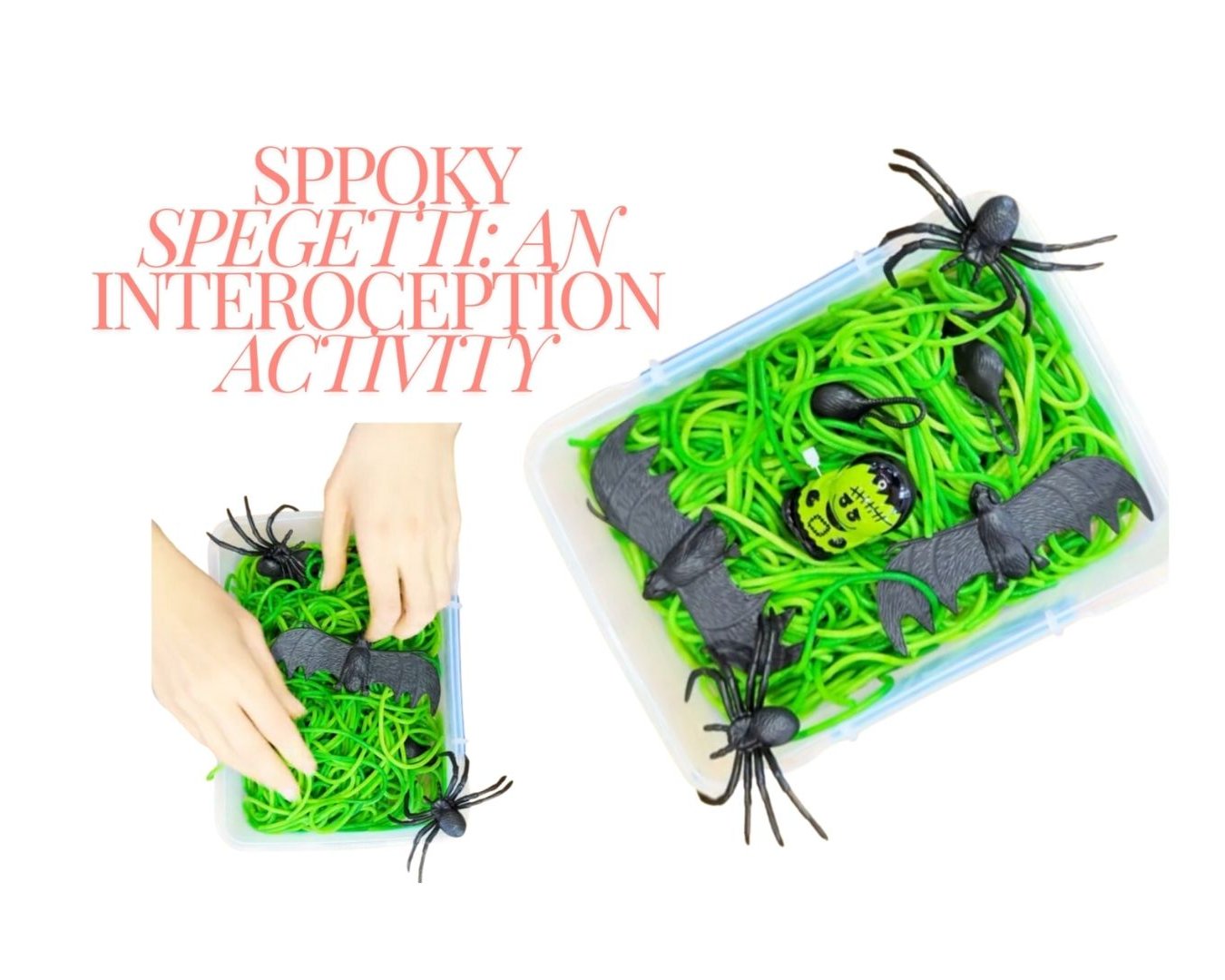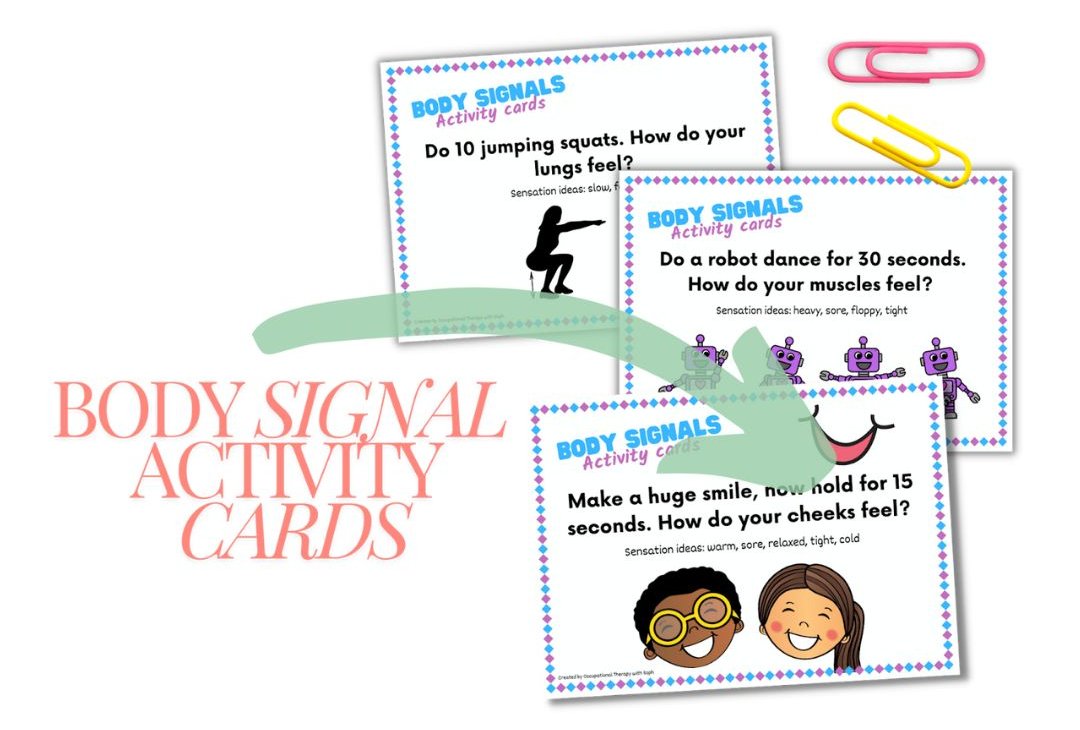This blog is your how-to-guide, for creating a fun halloween themed sensory activity to supports kids interoception skills – with spooky spaghetti! Interoception refers to our body’s ability to sense and interpret internal signals — things like hunger, thirst, the need to use the bathroom (we call these “homeostatic emotions”), or sensations that let us know our emotions, such as tiredness, the need to move, butterflies, or a foggy brain. It’s the internal awareness that allows us to recognise when we need to eat, take a break, or manage stress. For children, developing interoception helps them understand what their body is telling them, which lays the foundation for responding to their own physical and emotional needs.
I love using sensory-based play activities with kids. It’s a great way to engage younger children while being fun and purposeful. Spooky spaghetti provides an excellent opportunity for children to tune into their internal sensations (interoception) while playing! For example, asking children to notice how their bodies feel while manipulating different textures and objects. This tactile feedback helps kids practice being mindful of their internal responses — whether it’s feeling excitement, surprise, or calm. By engaging in sensory play, children can strengthen their interoceptive skills in a fun, hands-on way, making it easier for them to recognise their bodily and emotional signals in everyday life.
This blog will explore how to set up this fun interoception activity, talking prompts to use with students, fun adaptations, and how to make spooky spaghetti.
Building interoceptive awareness with ‘spooky spaghetti’ activity for kids
Tuning into internal body sensations
As children play with the spooky spaghetti, guide them to focus on how it feels in their hands. You might ask, “Is it cold, squishy, sticky, or slippery?” If you’ve added spooky props (like plastic spiders or snakes), have students explore these objects, pointing out differences between the textures. Encourage them to take a moment to observe these sensations closely and describe what they’re feeling.
Next, ask what body signals they notice in their hands. Are they cold, sweaty, or do their hands want to squish or move? Maybe the texture feels “too much” (overwhelming).
Linking to feelings and emotions
While exploring the child’s internal body sensations, you can link these sensations to possible feelings. Ask questions like, “Does the spaghetti make you feel calm, excited, or a little surprised?” This helps them connect the physical sensations they’re experiencing with their emotional responses. By doing so, you’re helping them practice paying attention to their body signals and thereby building their interoceptive awareness.
You can also help students recognise changes in their body, like feeling tense or relaxed. As they manipulate the spaghetti or objects, they may notice a shift in how their body feels, such as muscles loosening or their breathing slowing down. When working with younger kids or those who benefit from additional prompting and support, I like to use visuals (see picture below) to help the child build their language. You can check out my body signal visuals here 
Linking to regulation tools
I also like to highlight how, for some children, tactile play — like squishing and pulling spaghetti — can help manage tricky feelings by using tools to support emotional regulation. You can relate this to other situations where they might need to recognise when to take a break, such as during moments of frustration or overstimulation. However, it’s important to note that tactile play may be overwhelming for some children, and for them, this might not be a supportive regulation strategy. That said, this is still a valuable discussion to have with students to explore what might be helpful for those who feel overwhelmed or need extra support. When working with a group of children, pointing out differences in each child’s experiences and needs can provide a great learning opportunity for building self-awareness and empathy.
Adaptations for Spooky Spaghetti: Fun Halloween Sensory Activity for Kids
These interoception activities for kids make spooky spaghetti a blast, helping children build sensory awareness and SEL skills through playful exploration. For kids with sensory sensitivities, offer gloves or alternatives like dry rice.
| Adaptation | Objective | How it works | Guiding questions |
| Eyes-Closed Exploration | Explore their tactile system and focus on bodily signals. | Kids close their eyes and feel spooky spaghetti and hidden Halloween objects, relying on touch to notice sensations. | • What do you feel in your hands — soft, rough, or slimy?
• How does touching something you can’t see make you feel — surprised, curious, calm? |
| Hot vs. Cold Spaghetti Comparison | Notice the temperature’s impact on sensations and emotions. Explore body signals. | Kids compare warm (safety-cooled) and cold spaghetti to describe how each affects their hands and feelings. | • Which feels more relaxing or exciting?
• Does the cold spaghetti make your fingers tingle or feel different from the warm one? |
| Spooky Object Guessing Game | Combine sensory exploration with problem-solving. | Kids feel hidden Halloween objects (e.g., plastic spiders, toy eyeballs) in the spaghetti and guess what they are, solo or in groups. | • How do you feel when you can’t see the object — excited, nervous, curious?
• What clues does your body give you to guess what you’re touching? |
| Lucky Dip Spaghetti Play | Practice recognizing body signals via fun challenges. | Kids pull cards from the spaghetti with prompts to act out emotions or notice body signals (e.g., heartbeat, breathing). | • How did your body feel during the challenge — any changes?
• What emotion did you act out, and how does your body feel with it? |
Want ready-to-use interoception activity cards for these games? Grab my printable set here for instant Halloween sensory fun!
Spooky spaghetti recipe
You will need:
- 1-2 packages of spaghetti (depending on how much you need)
- Food coloring (gel or liquid)
- Cooking oil (optional)
- Large pot
- Water
- Colander or strainer
- Sensory bin or tray
- Optional spooky add-ins: plastic spiders, toy eyeballs, glow-in-the-dark items
Instructions:
Cook the Spaghetti:
- Fill a large pot with water and bring it to a boil.
- Add your spaghetti to the pot and cook according to the package instructions until the noodles are soft but not overcooked (al dente).
- Once the spaghetti is fully cooked, drain it using a colander or strainer.
Dye the Spaghetti:
- Add 3-4 drops of food coloring to the bowel of cooked spaghetti
- Toss the spaghetti thoroughly with the food coloring to ensure it’s evenly coated. You may want to use gloves to avoid staining your hands.
- After coloring, give the spaghetti a quick rinse under cold water to remove any excess dye. This also helps prevent students from getting food dye on their hands when playing with spaghetti.
- Lay the spaghetti on a clean surface or in a colander to dry for a few minutes. This will prevent it from sticking too much during play.
Set up:
- Add spaghetti to sensory tray
- Add any spooky prompts / objects and you are ready to go!
Spooky Spaghetti is a fun Halloween activity that helps kids build interoception (awareness of internal body signals like hunger or emotions) and boost social-emotional skills. Through simple sensory play — like feeling textures, guessing hidden objects, or drawing challenge cards — children learn to notice how their bodies feel, spot emotions, and practice self-control in exciting ways.
Looking for other interoception activities, check out my blog on body signal experiments here
Questions
If you have any questions or need further assistance please do not hesitate to get in touch here or at sophia.occupationaltherapy@gmail.com.







